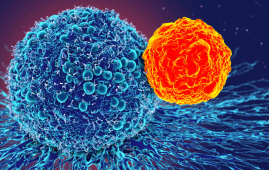

Heart rates are now easier to track than ever before. Because smartwatches can detect a pulse, all it takes is a fast turn of the wrist to check your heart rate. However, monitoring the cells responsible for heart rate is far more difficult -; and this has prompted researchers to develop novel methods of analyzing them. Dr. Joseph Wu, M.D., Ph.D., head of the Stanford Cardiovascular Institute and professor of medicine and radiology, has developed a new stem cell-derived model of heart tissue that sheds light on illnesses that arise when heart cells beat irregularly. Wu is particularly interested in tachycardia, a condition that causes an increase in heart rate and can progress to cardiomyopathy, a condition in which the heart loses its ability to adequately pump blood in persons with otherwise healthy heart structures.
“Tachycardia is probably more common than we think,” said postdoctoral scholar Chengyi Tu, Ph.D., who helped lead the work. “It’s believed to be underdiagnosed because an increase in heart rate is quite common in different types of heart diseases, and it gets masked.”
To investigate tachycardia-induced cardiomyopathy, the researchers created heart cells from human stem cells in order to learn how our body’s engine works in overdrive.
“Modeling tachycardia-induced cardiomyopathy with human stem cell-derived heart tissues allows us to better understand the impact of fast heart rates on our bodies,” said Wu, the Simon H. Stertzer, M.D., Professor who is the senior author of the study.
Engineering heart cells – Tachycardia
Unlike most organ tissues, heart cells are particularly difficult to culture in the lab. Patient heart cells cultivated in a dish de-differentiate – or lose their basic function and stop beating.
Ideally, you want to take samples of a patient’s heart just after disease diagnosis, during illness and after treatment. To validate your discovery, you need a lot of replicates to give you statistical power, but clinically, it’s impossible to sample so frequently.”
Chengyi Tu, Ph.D., postdoctoral scholar
Given the scarcity of tissue, Wu and his colleagues generated over 400 heart tissue samples from stem cells over the course of four years to study how heart cells operate.
“Making engineered heart tissue is very different from culturing cells in a dish. The timeline is very long,” Tu said. Generating heart cells from stem cells takes about two weeks; putting them together in a 3D tissue and maturing them takes almost two months.
Restoring the chemical balance
The researchers used a wired chamber to electrically stimulate the cells, causing tachycardia. They wanted to see if the cells could recover from tachycardia in 10 days. During the first five days, the cells’ ability to contract gradually decreased to around half of normal activity. However, as the researchers removed the electrical stimulation, the cells recovered completely in five days.
This is consistent with what doctors currently know about tachycardia-induced cardiomyopathy: it is largely reversible. When a person’s heart rate returns to normal, the function of their cardiac tissue returns to normal.
Another experiment involved inducing tachycardia in a different type of synthetic cardiac tissue. The team then supplemented the tissues with NAD (a chemical that facilitates energy reactions) after discontinuing stimulation and found the cardiac cells’ function return more quickly. By the first day, the supplemented tissues had recovered 83% of their former function, while the untreated group exhibited no recovery.
The team compared the modified cardiac tissues to clinical human data and canine model data to corroborate their findings. “I was surprised by how well the engineered heart tissues mimic the real human hearts,” Tu said.
Uncovering the molecular switch
The heart may struggle to pump blood to the rest of the body during tachycardia because the high pulse rate prevents the chambers of the heart from fully filling and contracting. If it lasts for several days or weeks, as it can in severe cases, blood arteries cease to give enough oxygen to the heart tissue and the rest of the body.
The heart uses fat as an energy source when it beats regularly, but breaking down fats demands a lot of oxygen. In the absence of oxygen, the heart’s fuel source shifts to sugar, a process known as metabolic rewiring. The fuel switch and hypoxia, or a lack of oxygen, both contribute to a drop in the NAD/NADH ratio, a critical chemical pair that aids in the activity of the SERCA protein in cardiac tissue.
“Varying levels of the SERCA protein act like a gas and brake pedal for a car,” Tu said. When researchers increase the amount of NAD, the heart’s gas pedal is thrusted, and the SERCA protein strengthens the heartbeat of the engineered cells. When decreased, the engineered heart tissues hit the brakes, making them beat more weakly.
Clinicians believe that providing patients NAD as an over-the-counter supplement or via IV injection can restore the chemical equilibrium and speed up recovery.
Alongside a new possible supplement to help patients recover from tachycardia, the research demonstrates the importance of new methods to model disease. Last year, President Joe Biden signed the FDA Modernization Act 2.0 into law, which removed the requirement for animal testing before human drug trials. “Now, there is more need for non-animal models to complement the animal models,” Tu said. “This work proves that it’s possible to model complex cardiac conditions using a universal non-animal model to study this disease and test possible therapeutics.”
For more information: Tu, C., et al. (2023). Tachycardia-induced metabolic rewiring as a driver of contractile dysfunction. Nature Biomedical Engineering. doi.org/10.1038/s41551-023-01134-x.
more recommended stories
 T-bet and the Genetic Control of Memory B Cell Differentiation
T-bet and the Genetic Control of Memory B Cell DifferentiationIn a major advancement in immunology,.
 Ultra-Processed Foods May Harm Brain Health in Children
Ultra-Processed Foods May Harm Brain Health in ChildrenUltra-Processed Foods Linked to Cognitive and.
 Parkinson’s Disease Care Advances with Weekly Injectable
Parkinson’s Disease Care Advances with Weekly InjectableA new weekly injectable formulation of.
 Brain’s Biological Age Emerges as Key Health Risk Indicator
Brain’s Biological Age Emerges as Key Health Risk IndicatorClinical Significance of Brain Age in.
 Children’s Health in the United States is Declining!
Children’s Health in the United States is Declining!Summary: A comprehensive analysis of U.S..
 Autoimmune Disorders: ADA2 as a Therapeutic Target
Autoimmune Disorders: ADA2 as a Therapeutic TargetAdenosine deaminase 2 (ADA2) has emerged.
 Is Prediabetes Reversible through Exercise?
Is Prediabetes Reversible through Exercise?150 Minutes of Weekly Exercise May.
 New Blood Cancer Model Unveils Drug Resistance
New Blood Cancer Model Unveils Drug ResistanceNew Lab Model Reveals Gene Mutation.
 Healthy Habits Slash Diverticulitis Risk in Half: Clinical Insights
Healthy Habits Slash Diverticulitis Risk in Half: Clinical InsightsHealthy Habits Slash Diverticulitis Risk in.
 Caffeine and SIDS: A New Prevention Theory
Caffeine and SIDS: A New Prevention TheoryFor the first time in decades,.

Leave a Comment